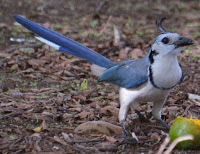 Appearance:
Appearance: Large oriole
Bright orange body
Black streaks on back
Deep orange-red head and breast
Black face and chin
Black wings with two bold white bars
Black tail with white corners
I saw their long, hanging nest a day or two before spotting the birds. It was attached to the tip of a branch overhanging the pool area of our condo. Apparently, the two birds had built the nest the week before we arrived. By the end of our week-long vacation, we could already hear the chirping of baby birds coming from within. Ah... the miracle of life.
Learn more about the Streak-backed Oriole.






